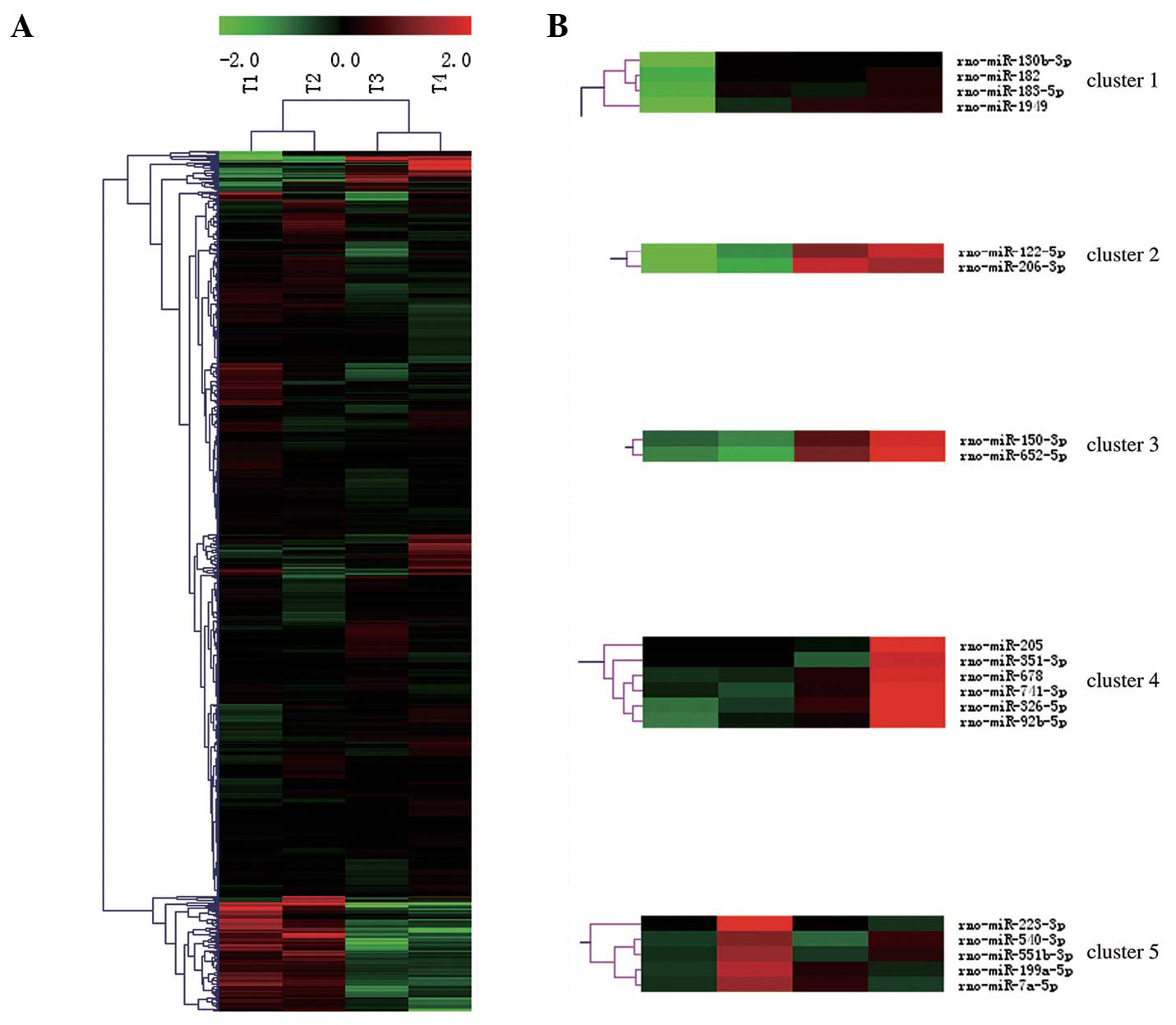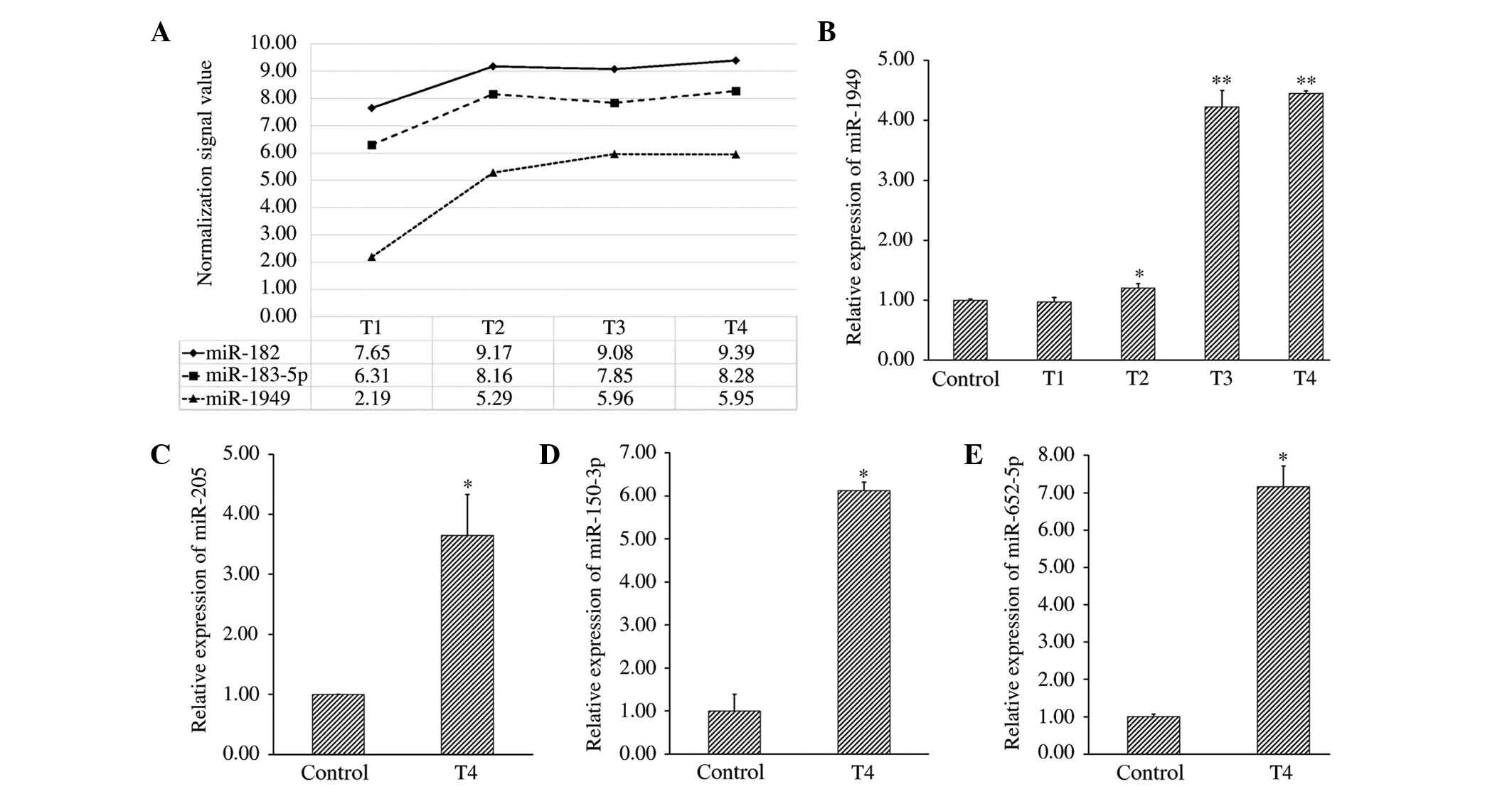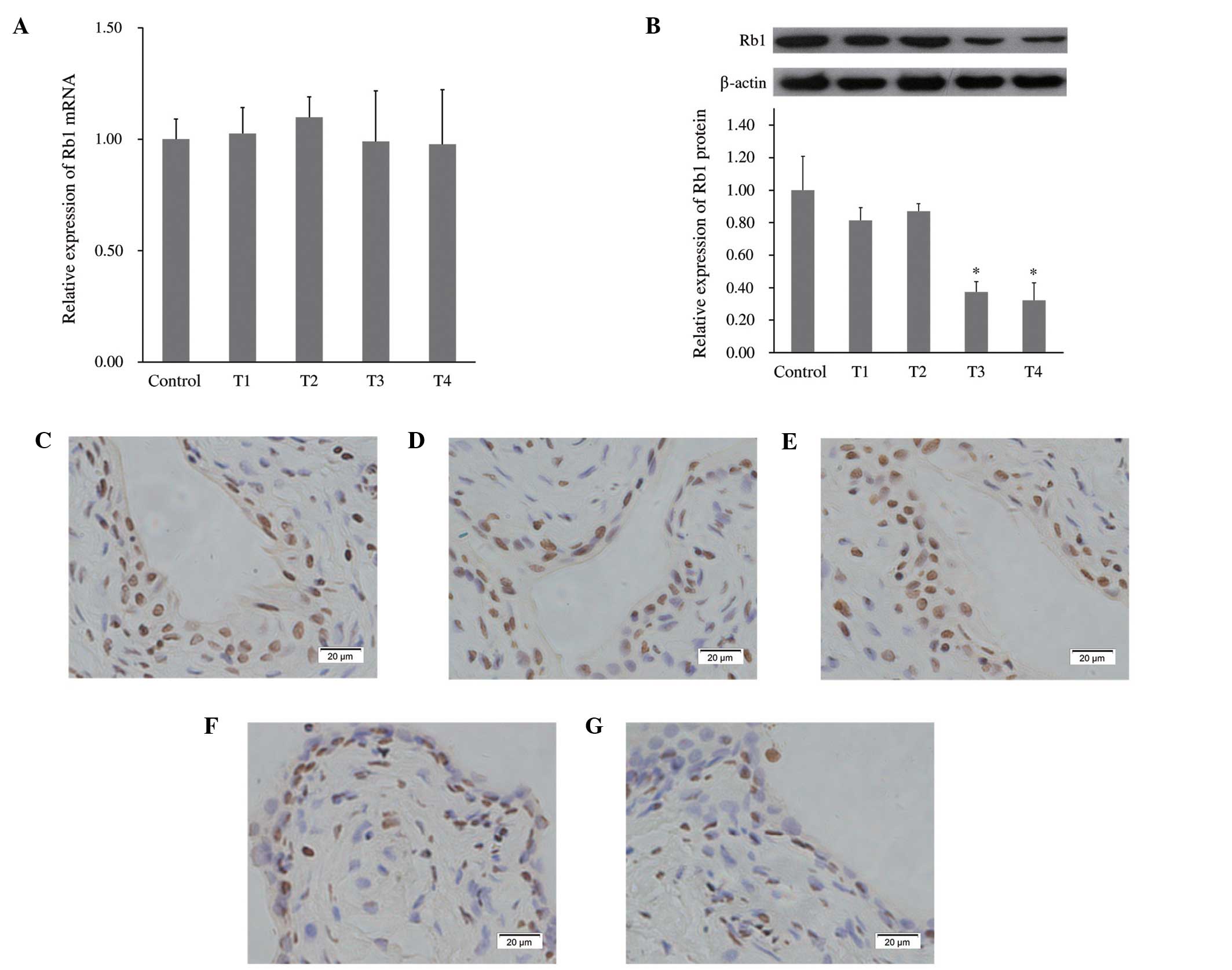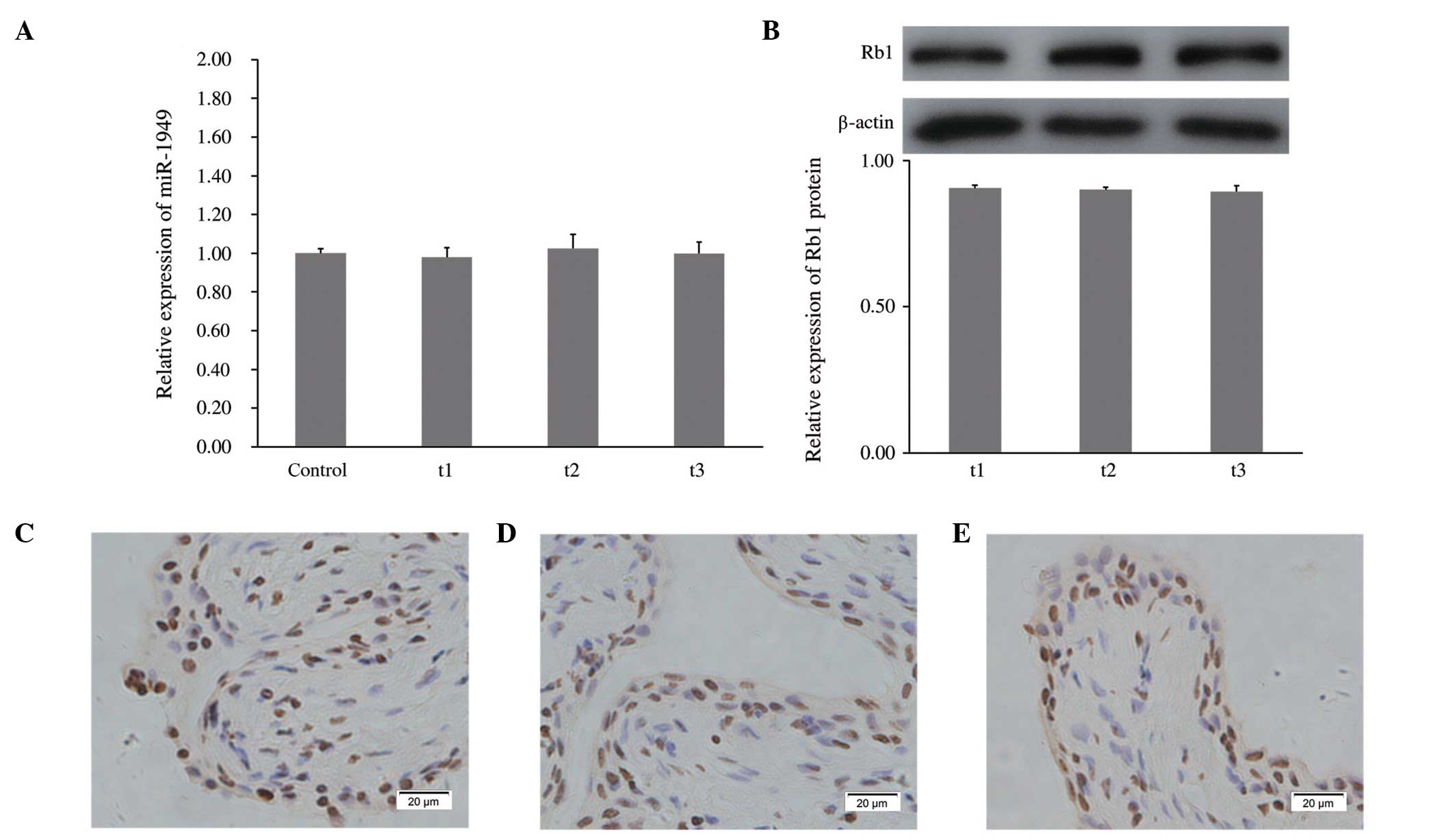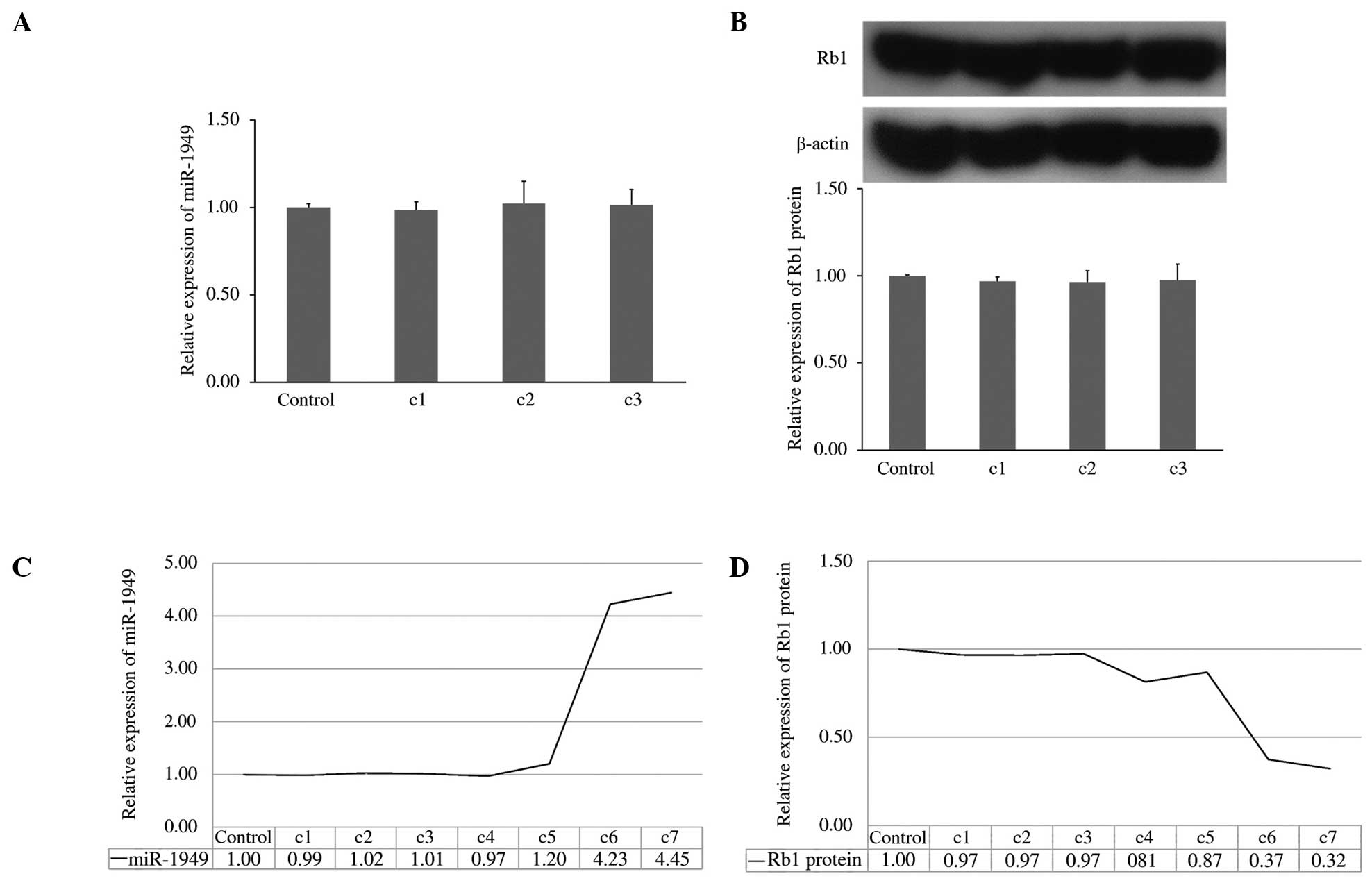|
1
|
Williams AE: Functional aspects of animal
microRNAs. Cell Mol Life Sci. 65:545–562. 2008. View Article : Google Scholar
|
|
2
|
Nagalla S, Shaw C, Kong X, et al: Platelet
microRNA-mRNA coexpression profiles correlate with platelet
reactivity. Blood. 117:5189–5197. 2011. View Article : Google Scholar : PubMed/NCBI
|
|
3
|
Hou J, Lin L, Zhou W, et al:
Identification of miRNomes in human liver and hepatocellular
carcinoma reveals miR-199a/b-3p as therapeutic target for
hepatocellular carcinoma. Cancer Cell. 19:232–243. 2011. View Article : Google Scholar : PubMed/NCBI
|
|
4
|
Munding JB, Adai AT, Maghnouj A, et al:
Global microRNA expression profiling of microdissected tissues
identifies miR-135b as a novel biomarker for pancreatic ductal
adenocarcinoma. Int J Cancer. 131:E86–E95. 2012. View Article : Google Scholar
|
|
5
|
Hua R, Shi J, Wang X, et al: Analysis of
the causes and types of traumatic spinal cord injury based on 561
cases in China from 2001 to 2010. Spinal cord. 51:218–221. 2013.
View Article : Google Scholar
|
|
6
|
Bejany DE, Lockhart JL and Rhamy RK:
Malignant vesical tumors following spinal cord injury. J Urol.
138:1390–1392. 1987.PubMed/NCBI
|
|
7
|
Groah SL, Weitzenkamp DA, Lammertse DP,
Whiteneck GG, Lezotte DC and Hamman RF: Excess risk of bladder
cancer in spinal cord injury: Evidence for an association between
indwelling catheter use and bladder cancer. Arch Phys Med Rehabil.
83:346–351. 2002. View Article : Google Scholar : PubMed/NCBI
|
|
8
|
Subramonian K, Cartwright RA, Harnden P
and Harrison SC: Bladder cancer in patients with spinal cord
injuries. BJU Int. 93:739–743. 2004. View Article : Google Scholar : PubMed/NCBI
|
|
9
|
Kalisvaart JF, Katsumi HK, Ronningen LD
and Hovey RM: Bladder cancer in spinal cord injury patients. Spinal
Cord. 48:257–261. 2010. View Article : Google Scholar
|
|
10
|
Kaufman JM, Fam B, Jacobs SC, et al:
Bladder cancer and squamous metaplasia in spinal cord injury
patients. J Urol. 118:967–971. 1977.PubMed/NCBI
|
|
11
|
Geisse LJ and Tweeddale DN: Pre-clinical
cytological diagnosis of bladder cancer. J Urol. 120:51–56.
1978.PubMed/NCBI
|
|
12
|
Pannek J: Transitional cell carcinoma in
patients with spinal cord injury: A high risk malignancy? Urology.
59:240–244. 2002. View Article : Google Scholar : PubMed/NCBI
|
|
13
|
West DA, Cummings JM, Longo WE, Virgo KS,
Johnson FE and Parra RO: Role of chronic catheterization in the
development of bladder cancer in patients with spinal cord injury.
Urology. 53:292–297. 1999. View Article : Google Scholar : PubMed/NCBI
|
|
14
|
Lau P, Verrier JD, Nielsen JA, Johnson KR,
Notterpek L and Hudson LD: Identification of dynamically regulated
microRNA and mRNA networks in developing oligodendrocytes. J
Neurosci. 28:11720–11730. 2008. View Article : Google Scholar : PubMed/NCBI
|
|
15
|
Sparkes RS, Sparkes MC, Wilson MG, et al:
Regional assignment of genes for human esterase D and
retinoblastoma to chromosome band 13q14. Science. 208:1042–1044.
1980. View Article : Google Scholar : PubMed/NCBI
|
|
16
|
Miyamoto H, Shuin T, Torigoe S, Iwasaki Y
and Kubota Y: Retinoblastoma gene mutations in primary human
bladder cancer. Br J Cancer. 71:831–835. 1995. View Article : Google Scholar : PubMed/NCBI
|
|
17
|
Mitra AP, Hansel DE and Cote RJ:
Prognostic value of cell-cycle regulation biomarkers in bladder
cancer. Semin Oncol. 39:524–533. 2012. View Article : Google Scholar : PubMed/NCBI
|
|
18
|
Workman P, Aboagye EO, Balkwill F, et al:
Guidelines for the welfare and use of animals in cancer research.
Br J Cancer. 102:1555–1577. 2010. View Article : Google Scholar : PubMed/NCBI
|
|
19
|
Ban DX, Kong XH, Feng SQ, Ning GZ, Chen JT
and Guo SF: Intraspinal cord graft of autologous activated Schwann
cells efficiently promotes axonal regeneration and functional
recovery after rat’s spinal cord injury. Brain Res. 1256:149–161.
2009. View Article : Google Scholar
|
|
20
|
Zhou HX, Li XY, Li FY, et al: Targeting
RPTPsigma with lentiviral shRNA promotes neurites outgrowth of
cortical neurons and improves functional recovery in a rat spinal
cord contusion model. Brain research. 1586:46–63. 2014. View Article : Google Scholar
|
|
21
|
Liu Y, Wang CY, Kong XH, et al: Novel
multifunctional polyethylene glycoltransactivating-transduction
protein-modified liposomes cross the blood-spinal cord barrier
after spinal cord injury. J Drug Target. 18:420–429. 2010.
View Article : Google Scholar
|
|
22
|
Andreollo NA, Santos EF, Araújo MR and
Lopes LR: Rat’s age versus human’s age: What is the relationship?
Arq Bras Cir Dig. 25:49–51. 2012.In English, Portuguese. View Article : Google Scholar : PubMed/NCBI
|
|
23
|
Quinn R: Comparing rat’s to human’s age:
How old is my rat in people years? Nutrition. 21:775–777. 2005.
View Article : Google Scholar : PubMed/NCBI
|
|
24
|
Lee H, Jun SY, Lee YS, Lee HJ, Lee WS and
Park CS: Expression of miRNAs and ZEB1 and ZEB2 correlates with
histopathological grade in papillary urothelial tumors of the
urinary bladder. Virchows Arch. 464:213–220. 2014. View Article : Google Scholar
|
|
25
|
Ratert N, Meyer HA, Jung M, et al: miRNA
profiling identifies candidate mirnas for bladder cancer diagnosis
and clinical outcome. J Mol Diagn. 15:695–705. 2013. View Article : Google Scholar : PubMed/NCBI
|
|
26
|
Tran MN, Choi W, Wszolek MF, et al: The
p63 protein isoform ΔNp63α inhibits epithelial-mesenchymal
transition in human bladder cancer cells: Role of MIR-205. J Biol
Chem. 288:3275–3288. 2013. View Article : Google Scholar :
|
|
27
|
Dip N, Reis ST, Timoszczuk LS, et al:
Stage, grade and behavior of bladder urothelial carcinoma defined
by the microRNA expression profile. J Urol. 188:1951–1956. 2012.
View Article : Google Scholar : PubMed/NCBI
|
|
28
|
Wang G, Chan ES, Kwan BC, et al:
Expression of microRNAs in the urine of patients with bladder
cancer. Clin Genitourin Cancer. 10:106–113. 2012. View Article : Google Scholar : PubMed/NCBI
|
|
29
|
Wiklund ED, Bramsen JB, Hulf T, et al:
Coordinated epigenetic repression of the miR-200 family and miR-205
in invasive bladder cancer. Int J Cancer. 128:1327–1334. 2011.
View Article : Google Scholar
|
|
30
|
Neely LA, Rieger-Christ KM, Neto BS, et
al: A microRNA expression ratio defining the invasive phenotype in
bladder tumors. Urol Oncol. 28:39–48. 2010. View Article : Google Scholar
|
|
31
|
Gottardo F, Liu CG, Ferracin M, et al:
Micro-RNA profiling in kidney and bladder cancers. Urol Oncol.
25:387–392. 2007. View Article : Google Scholar : PubMed/NCBI
|
|
32
|
Friedman JM, Liang G, Liu CC, et al: The
putative tumor suppressor microRNA-101 modulates the cancer
epigenome by repressing the polycomb group protein EZH2. Cancer
Res. 69:2623–2629. 2009. View Article : Google Scholar : PubMed/NCBI
|
|
33
|
Han Y, Chen J, Zhao X, et al: MicroRNA
expression signatures of bladder cancer revealed by deep
sequencing. PLoS One. 6:e182862011. View Article : Google Scholar : PubMed/NCBI
|
|
34
|
Yamada Y, Enokida H, Kojima S, et al:
MiR-96 and miR-183 detection in urine serve as potential tumor
markers of urothelial carcinoma: Correlation with stage and grade,
and comparison with urinary cytology. Cancer Sci. 102:522–529.
2011. View Article : Google Scholar
|
|
35
|
Pignot G, Cizeron-Clairac G, Vacher S, et
al: microRNA expression profile in a large series of bladder
tumors: Identification of a 3-miRNA signature associated with
aggressiveness of muscle-invasive bladder cancer. Int J Cancer.
132:2479–2491. 2013. View Article : Google Scholar
|
|
36
|
Yoshino H, Seki N, Itesako T, Chiyomaru T,
Nakagawa M and Enokida H: Aberrant expression of microRNAs in
bladder cancer. Nat Rev Urol. 10:396–404. 2013. View Article : Google Scholar : PubMed/NCBI
|
|
37
|
Zhang QH, Sun HM, Zheng RZ, et al:
Meta-analysis of microRNA-183 family expression in human cancer
studies comparing cancer tissues with noncancerous tissues. Gene.
527:26–32. 2013. View Article : Google Scholar : PubMed/NCBI
|
|
38
|
Xu Q, Seeger FH, Castillo J, et al:
Micro-RNA-34a contributes to the impaired function of bone
marrow-derived mononuclear cells from patients with cardiovascular
disease. J Am Coll Cardiol. 59:2107–2117. 2012. View Article : Google Scholar : PubMed/NCBI
|
|
39
|
Ito T, Yagi S and Yamakuchi M:
MicroRNA-34a regulation of endothelial senescence. Biochem Biophys
Res Commun. 398:735–740. 2010. View Article : Google Scholar : PubMed/NCBI
|
|
40
|
Nishino J, Kim I, Chada K and Morrison SJ:
Hmga2 promotes neural stem cell self-renewal in young but not old
mice by reducing p16Ink4a and p19Arf Expression. Cell. 135:227–239.
2008. View Article : Google Scholar : PubMed/NCBI
|
|
41
|
Li S, Zhu J, Zhang W, et al: Signature
microRNA expression profile of essential hypertension and its novel
link to human cytomegalovirus infection. Circulation. 124:175–184.
2011. View Article : Google Scholar : PubMed/NCBI
|
|
42
|
Liu CG, Calin GA, Volinia S and Croce CM:
MicroRNA expression profiling using microarrays. Nat Protoc.
3:563–578. 2008. View Article : Google Scholar : PubMed/NCBI
|
|
43
|
Brown BD, Gentner B, Cantore A, et al:
Endogenous microRNA can be broadly exploited to regulate transgene
expression according to tissue, lineage and differentiation state.
Nat Biotechnol. 25:1457–1467. 2007. View Article : Google Scholar : PubMed/NCBI
|
|
44
|
Sarasin-Filipowicz M, Krol J, Markiewicz
I, Heim MH and Filipowicz W: Decreased levels of microRNA miR-122
in individuals with hepatitis C responding poorly to interferon
therapy. Nat Med. 15:31–33. 2009. View Article : Google Scholar : PubMed/NCBI
|
|
45
|
Esuvaranathan K, Chiong E, Thamboo TP, et
al: Predictive value of p53 and pRb expression in superficial
bladder cancer patients treated with BCG and interferon-alpha.
Cancer. 109:1097–1105. 2007. View Article : Google Scholar : PubMed/NCBI
|
|
46
|
Lu X, Wu L, Liu Z, Xie L and Wang S:
Peripheral blood mono-nuclear cells inhibit proliferation and
promote apoptosis of HeLa cells following stimulation with Bacillus
Calmette-Guerin. Exp Ther Med. 5:561–566. 2013.PubMed/NCBI
|
|
47
|
Kawaichi S: Cancer of bladder os spinal
cord injury patients. Proceed Ninth Ann Clin Cord Injury Conf; pp.
104–105. 1961
|
|
48
|
Silverman DT, Hartge P, Morrison AS and
Devesa SS: Epidemiology of bladder cancer. Hematol Oncol Clin North
Am. 6:1–30. 1992.PubMed/NCBI
|
|
49
|
Burch JD, Rohan TE, Howe GR, et al: Risk
of bladder cancer by source and type of tobacco exposure: A
case-control study. Int J Cancer. 44:622–628. 1989. View Article : Google Scholar : PubMed/NCBI
|



